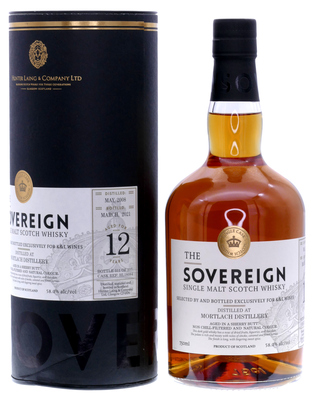|
|
Release Notes
The beast of Dufftown returns. Part of our trio of young sherry cask whiskies and very famous for how well it takes to sherry – the rich and meaty Mortlach has long been appreciated by single malt aficionados for its unusually hearty character. The distillery is well known for its different approach to distillation as well – a 2.81 times distilled regimen that sets it apart from the typical double distillation found all over Scotland. Loaded with tobacco, dark chocolate, espresso, black cherry, and honeyed raisins. Big, intense, and every bit Mortlach.
K&L Wine Merchants
3rd Party Tasting Notes
This dark gold whisky has a nose of dried fruits, liquorice and chocolate. The palate is rich and meaty with notes of smoke, caramel and forest berries. The finish is long, with lingering sweet spice.
From the Bottle
The Bottler: Hunter Laing & Company
| Established: 2010 |
| Silent since: False |
| Address: Glasgow |
| → website |
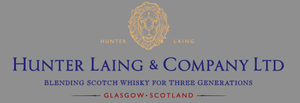
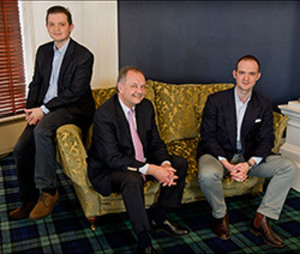
Founded in 2010 as a breakaway company from the original Douglas Laing company which retains its original name and headquarters,run by Fred Laing and his daughter Cara. The new company Hunter Lain is headed by Stewart Laing and his 2 sons Scot and Andrew. Brands include Old Malt Cask, Old and Rare, Douglas of Drumlanrig and the Hepburn's Choice series.
from Various Online
The Distillery: Mortlach
| Established: 1823 |
| Silent since: False |
| Address: Dufftown, Keith, Banffshire AB55 4AQ, UK |
2004 - The Mortlach 32yo 1971/2004 (50.1%, OB) is released.
The Mortlach distillery was the first distillery in Dufftown, pre-dating the next one (Glenfiddich) by over four decades. Mortlach was founded in 1823 by James Findlater, who was joined by Alexander Gordon and James Macintosh the next year. They acquired partial ownership.
Mortlach has one larch washbacks for every one of its six stills and a semi-lauter mash tun that was added in 1996. More than two decades earlier (in 1964) there was a refurbishment that was so considerable that it pretty much meant a that the whole distillery was rebuilt, at least on the inside. The exterior was the only part of Mortlach that remained largely intact at the time; although the pagoda roofs would have a strictly decorative function in the future.
Mortlach"s floor maltings remained operational until 1968. Larch worm-tubs on a platform outside the still house are still used to condense the spirit. New Lauter mashtuns were installed in 1996. The Mortlach distillery grounds feature five traditional "dunnage" warehouses that provide storage capacity for 21,000 casks.
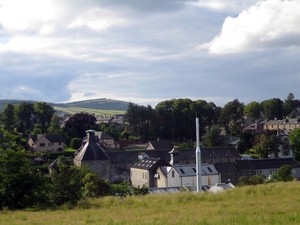
In 1853 or 1854 part of Mortlach was taken over by George Cowie Senior, a railway company surveyor and (later) the mayor of Dufftown. When John Alexander Gordon passed away in 1867 he became the sole owner of the Mortlach. His son George Cowie Junior started work at the distillery in 1895, two years before the number of stills was expanded from three to six in 1897. This was an unusually large number of pot stills in those days - the expansion of the production capacity was probably inspired by the massive "whisky boom" of the time, which effectively meant that all the produced whisky could be sold.
When the extra stills were installed in 1897 the owners also added a railway siding that linked Mortlach with the Dufftown train station. One year later electric lights were added, as well as a hydraulic lift system in the warehouses that was used for lifting casks and other loads to the upper floors. This were the last modernisations of the distillery until 1923 when Alexander Cowie decided to sell Mortlach to John Walker & Sons - the company that became part of Distillers Company Limited (DCL; predecessors of Diageo) two years later in 1925. The configuration of the six stills at Mortlach is unusual - and probably unique in Scotland. The "partial triple distillation" that is used at the Mortlach distillery is a variation of the technique that is in use at Springbank and Benrinnes.
The initial owners didn"t manage to keep the distillery running for more than a decade; Mortlach was sold on to John Robertson in 1831 for the ridiculous amount of 270 GBP. This marked the start of a number of purchases by different (part) owners, including A. & T. Gregory, John Alexander Gordon and brothers James and John Grant. Mortlach was inactive for a few years (at least as far as the production of malt whisky is concerned) - the buildings were used as a brewery and as a church,
Just like the founder of Glenlivet (also constructed in 1823), the founders of Mortlach hoped to benefit from the new Excise Act. If they benefited at all it was only for a few years; Mortlach was sold on to new owners for a number of times and some of the buyers didn"t even intend to actually produce any whisky. For example, when John & James Grant of Glen Grant bought the distillert they removed the distilling equipment and left it silent - probably as a way to reduce competition. After Mortlach had been used as a brewery for a few years in was converted back into a distillery in 1852, using brand new equipment to produce a whisky with the name "The Real John Gordon" - a reference to the owner at the time.
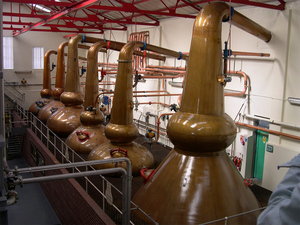
In the New Millenium
2002 - For a long time the closest thing to an official bottling of Mortlach were the licensed bottlings by Gordon & Macphail. However, the Mortlach 19yo "Manager"s Dram" (55.8%, OB, Refill cask, 2002) marked a new beginning.
2009 - The Mortlach 1997/2009 "Managers" Choice" (57.1%, OB, C#6802, 240 Bts.) appears.
Trivia:
- In 1886 a distillery employee by the name of William Grant left Mortlach after almost twenty years. Apparently he had learned quite a bit about the fine art of distillation during that time; within a year after he had left Mortlach he built his own distillery; Glenfiddich.
- Mortlach malt whisky is an important component of the Johnnie Walker Black Label blend.
- The Mortlach distillery was built around a well that had been previously used for illicit whisky production.
from Malt Maniacs
The Owner: Diageo
| Established: 1997 |
| Silent since: False |
| Address: 8 Henrietta Place, London, W1G ONB, UK |
| → website |
Diageo also distributes Unicum, its lighter-bodied variant Zwack and Jose Cuervo tequila products in North America. However, Cuervo operates as a separate company in Mexico and is not owned by Diageo. Similarly Grand Marnier is distributed by Diageo in many markets, including exclusively in Canada, and a deal was reached in 2009 to significantly expand this partnership in Europe.
Furthermore, Diageo owns the Gleneagles Hotel.
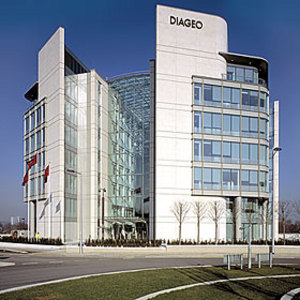
Diageo was formed in 1997 from the merger of Guinness plc and Grand Metropolitan plc. The creation was driven by the two executives Anthony Greener and Philip Yea at Guinness plus George Bull and John McGrath of Grand Metropolitan. The product portfolios of Guinness and Grand Met were largely complementary with little overlap.
Diageo is the world"s biggest whisky producer with 28 malt distilleries and two grain distilleries.The company operates the Scotch whisky distilleries of Auchroisk, Benrinnes, Blair Athol (situated at Pitlochry), Caol Ila, Cardhu, Knockando, Glen Elgin, Clynelish, Cragganmore, Dalwhinnie, Glenkinchie, Glen Ord, Lagavulin, Oban, Royal Lochnagar, Strathmill, Talisker, Teaninich, Mannochmore, Mortlach and Glenlossie, which are sold not only under their own name but used to make the various blended scotch whiskies sold by the company, and owns the stock of many closed distilleries such as Port Ellen, Rosebank, Brora, Convalmore, Glen Albyn, North Brechin, Banff, and Linlithgow. The company have opened a new malt distillery adjacent to their maltings at Roseisle (1st new make spirit produced Spring 2009). This will be one of the largest malt distilleries in Scotland. The new building contains 14 traditional copper pot stills. An expansion programme is also underway at its Cameron Bridge Grain Distillery in Fife that will make it the largest grain distillery in Scotland. Diageo also owns the Port Dundas Grain Distillery in Glasgow, and jointly operates the North British Grain Distillery in Gorgie, Edinburgh, with The Edrington Group.
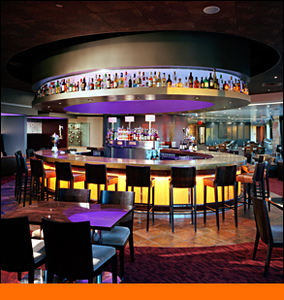
Diageo plc (LSE: DGE, NYSE: DEO) is the largest multinational beer, wine and spirits company in the world. The company is listed on the London Stock Exchange and has American Depositary Receipts listed on the New York Stock Exchange. The word Diageo was formed from the Latin dia (day) and the Greek geo (World), symbolising the use of the company"s brands every day, everywhere. Its head office is located in the City of Westminster in London. It is a constituent of the FTSE 100 Index.
Trivia:
- In December 2003, Diageo provoked controversy over its decision to change its Cardhu brand Scotch whisky from a single malt to a vatted malt (also known as a pure malt) whilst retaining the original name and bottle style. Diageo took this action because it did not have sufficient reserves to meet demand in the Spanish market, where Cardhu had been successful. After a meeting of producers, Diageo agreed to make changes.
- In 2006, the Cardhu brand quietly changed back to being a single malt.
- In July 2009, Diageo announced that, after nearly 200 years of association with the town of Kilmarnock, they would be closing the Johnnie Walker blending and bottling plant as part of restructuring to the business. This would make 700 workers unemployed and caused outrage from press, local people and politicians. A campaign against this decision was launched by the local SNP MSP Willie Coffey and Labour MP Des Browne. A petition was drawn up against the Diageo plans, which also involves the closure of the historic Port Dundas Grain Distillery in Glasgow.
- In February 2009 it was reported in the Guardian that the company had restructured itself so as to avoid paying tax in the U.K., despite much of its profits being generated in the U.K.
- Diageo is engaged in a tax scheme in the United States of America, commonly referred to as the "Rum Bailout", which will guarantee it USD$3 billion in revenues and profits.
- The National Puerto Rican Coalitionplans to run a series of ads in New York City and Puerto Rico urging a boycott of Diageo-owned alcoholic drinks to protest the giant British-owned corporation"s controversial production move of its Captain Morgan rum from Puerto Rico to the U.S. Virgin Islands.
from Wikipedia
